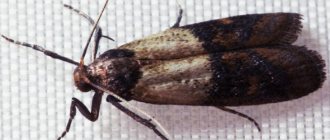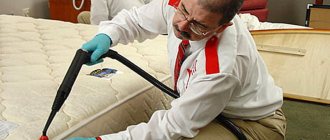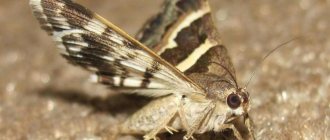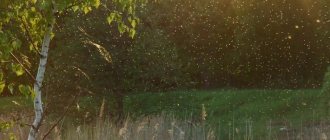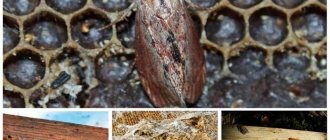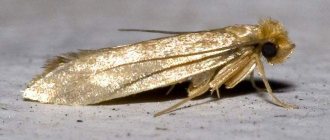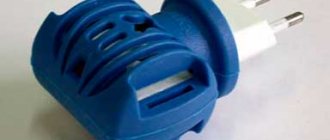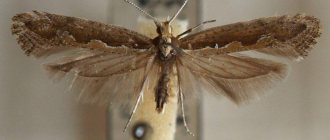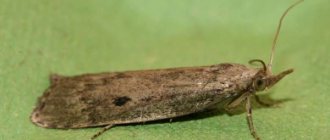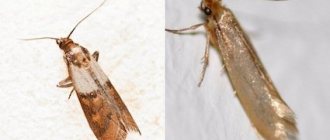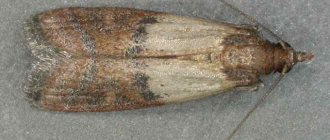- What types of moths are there?
- What do moth larvae look like?
- Features of reproduction and development
- Where do moths and their offspring come from in an apartment?
- Effective means and methods for exterminating moths and their larvae
- Non-chemical methods
- Chemicals
- Folk recipes
- Prevention measures
- Professional treatment of premises against moths and larvae
Small lepidopteran butterflies measuring 5-8 mm, the appearance of which in the house is associated with damage to fur clothing and food supplies, belong to the moth family and are considered pests. The insect itself causes damage to human property. Dangerous are moth larvae, small voracious caterpillars that can hopelessly spoil food and things in a couple of months. To effectively fight moth larvae in an apartment, it is worth studying the habits, gastronomic preferences, and choosing means to kill parasites.
What types of moths are there?
Almost every house or apartment has favorable conditions for the settlement of small pest butterflies. Main types of moles:
- grain, gray-brown in color, settles in cereals: rice, buckwheat, flour;
- wardrobe, the largest of the apartment types. The jaw apparatus of the larvae is maximally adapted to biting through dense materials;
- fur coat, the larvae of which destroy fur products;
- furniture, the food preferences of which follow from the name. Caterpillars in their growth stage spoil the fabric upholstery of sofas and armchairs.
In areas where bees are bred, a wax butterfly is found that feeds on honey and bee larvae. There are no known cases of this species settling in houses. The larvae of all these species look like white worms, differing slightly in size.
Nutrition
The appearance of moth caterpillars can be very deceiving. They are voracious and can cause significant harm. In human housing, the conditions for them are the most comfortable, compared to ordinary natural conditions, which is why they often appear on shelves in hordes.
There is an important feature of the food moth : it does not prefer certain foods. For example, having got into a jar of rice and quickly destroyed it, the worm happily moves into flour or wheat grits.
The situation is also the same for clothes moths . If the fur coat is destroyed, and the owner has not yet given it another coat, then she can switch to a more unbalanced diet, for example, on a carpet. If the situation is extremely difficult, there are no carpets, then pests can even use semi-synthetic things.
What do moth larvae look like?
The body length of the parasite is 6-12 mm, thickness is up to 2 mm. Color – white, pale yellow. The head is darker. There are 6 pairs of limbs. The gnawing jaws are clearly visible on the head. Interestingly, the mouthparts of the food moth are capable of chewing through polyethylene, but cannot cope with paper. Adults do not have mouthparts. During their short life they do not feed at all.
If you suspect an infection, it is easier to look in the apartment not for the worms themselves, but for traces of their vital activity. The larva of the fur moth leaves characteristic tracks of “cut” pile on things. In cereals, the traces look like a dusty substance. Wool sweaters have visible holes. The brown furniture butterfly chooses for laying places that are known to provide food for future caterpillars. Holes appear on sofa upholstery and fabric headboards soon after they hatch.
The main enemy of things
Caterpillars consume only natural ingredients. Therefore, it is difficult to find eggs or worms on clothes made from synthetic materials. Larvae prefer products that are more than 2–3 years old. After all, such things have very thin fibers, which are much easier to destroy. One caterpillar requires few products. But adult insects lay about 90–100 eggs at a time, from which caterpillars emerge and rapidly progress through developmental stages. Killing them is quite difficult.
Features of reproduction and development
Male moths are afraid of bright light; they prefer to fly in the dark.
Mature butterflies emerge from cocoons in late autumn. Already on the second day of life they mate. The fertilized female selects dark places to lay eggs. 4-6 days after the end of the clutch, the female moth dies, the males cease to exist immediately after mating. One clutch can contain up to 70-100 eggs. Females lay their eggs in several secluded locations to increase the offspring's chances of successfully hatching and pupating.
One and a half to two weeks after laying, larvae appear from the eggs. Before turning into a cocoon, they go through up to five stages of molting, depending on the subspecies. They eat actively throughout the growth period. In two months, a colony of larvae can chew through half the contents of a wardrobe. A developed caterpillar, reaching 12 mm in length, stops feeding and sinks into a durable spindle-shaped cocoon. In it she turns into a doll.
The characteristics of reproduction demonstrate double harm: adult moths do not cause damage to property, but throughout their lives they produce offspring that are maximally adapted to this activity. It is the larval form that is dangerous for things and products, since the butterfly does not have a developed oral apparatus and digestive system. Spoiled products should absolutely not be used for food after any processing. Excrement and covering residues are toxic, they can cause stomach upset, allergic reactions, and a weakened immune system.
It is not difficult to understand what house moths feed on from the names of the subspecies of butterflies. Clothes prefers fur and cotton, but will not touch products made from synthetic materials. The grain moth attacks foods and does not disdain fruits, nuts, berries and vegetables. Worm nests can be found in spices and chocolate.
Why is the parasite dangerous?
Moths do not bite people or domestic animals and are not carriers of diseases. It causes significant harm to humans, as it spoils food supplies, clothing, and household utensils in large quantities.
Favorite “dishes” of insects:
cereals, flour, pasta supplies; cookies, crackers; nuts, seeds.
With pleasure, the moth eats available supplies of sweets (for example, candy). In places where it settles, there is a sticky web and microscopic scales. Worm larvae, with their powerful jaws, are able to gnaw through entire tunnels in food supplies, simultaneously filling them with their own excrement.
Read about how to clean carpet without a vacuum cleaner without removing it from the floor at this address.
The moth causes severe damage to things in which it manages to lay eggs. It can be:
carpeting, upholstery of upholstered furniture made from natural fabrics (especially those with a high wool content); woolen sweaters, jackets, socks, scarves, hats, mittens, down scarves; fur coats, jackets, hats.
If the reproduction of moths is not stopped in time, a horde of larvae can be turned into a fur coat completely unusable during the summer season. The larvae eat away entire bald spots on fur, make holes in woolen materials, and leave holes in sofas and armchairs.
The larva of a food moth will mature in 5 weeks, and a clothes moth in 3 months before turning into a cocoon pupa, from which a gray velvety butterfly moth will subsequently hatch. The butterfly will no longer eat food and clothing, but during its short three-week life it will have time to lay a new batch of eggs.
Where do moths and their offspring come from in an apartment?
The sanitary condition of a human home and the appearance of a harmful house butterfly are in no way related events. The population may choose luxury apartments and housing of owners who are not prone to neatness. The main thing is the presence of an extensive nutritional base.
Can a moth come out of nowhere? If we consider the surrounding space to be such a substance, the answer is positive. A butterfly can fly into an apartment through an open window or an open door and stay.
Other methods of penetration:
- along with old furniture, the upholstery of which contained eggs;
- with things purchased in thrift stores;
- with products purchased from dubious markets;
- with pet hair.
Even if you haven’t seen a butterfly in your apartment, there are signs by which you can guess that there is an infestation. These are remnants of skin in boxes, which caterpillars shed when molting, stuck together lumps of cereals in jars, “cobwebs” on things, in the corners of cabinets.
The most favorable temperature for the existence of pest butterflies is 21-23°C. The warmer the apartment, the faster insects develop. But at temperatures above 30 °C, the voracious caterpillars die. Uninvited inhabitants of cabinets and containers with food supplies will never go outside in search of food. There they have natural enemies - birds, spiders, fresh cool air.
Lifestyle
The development period of caterpillars depends on environmental conditions. Clothes moth prefers a temperature of 23-25 degrees. Under these conditions, it will take 3 months to develop. If the temperature rises to 30 degrees, this period will be reduced to 2 months. If the temperature in the apartment is maintained at 13 degrees, the caterpillar will be forced to eke out its existence for as long as 6 months and 10 days.
If the temperature drops below 13 or exceeds 30, the caterpillars will die.
On a note!
The movement of the pest between human dwellings occurs with the help of humans. Most likely, it is the caterpillars that are carried, since butterflies are practically incapable of flying. The larvae are brought into the house with clothes, carpets, and food.
Effective means and methods for exterminating moths and their larvae
To get rid of moth larvae and adult butterflies, humanity has invented many methods of varying effectiveness. The recipes contain classic drugs, such as naphthalene and new generation insecticides. It is difficult to name the best remedy; you need to act experimentally. The fight should begin immediately after at least one small butterfly is noticed.
Before processing, you should throw away all contaminated food, damaged clothing, and clean the room. If the item of clothing can be saved, it is subjected to thorough cleaning or chemical treatment.
Struggle
Although the larva does not look too dangerous outwardly, the fight against moths must begin as soon as the first signs of its appearance are noticed. Methods to combat it are quite simple and effective.
Clothes and furniture moths can be removed by treating furniture, carpets and clothing with chemicals sold in any hardware store. After processing and keeping for a certain time, things must be washed, and the furniture must be thoroughly washed.
The larvae do not hold onto clothing tightly, so even with normal shaking they begin to fall. If you hang things out in the sun or frost, the caterpillars will die. How to deal with moth larvae:
- Shake all your clothes.
- Warm up in the sun or wash at a temperature of 50 degrees.
- Spray clothes and closets with insecticides.
- Use scented repellents to prevent insects from re-invading.
Fighting food moths is somewhat more difficult. It is impossible to poison the larvae with chemicals, since the poison will get into the food. The following set of measures should be taken:
- Throw away all bags and packaging containing caterpillars;
- Kill all visible butterflies;
- Treat food storage areas with aerosols against flying insects;
- Wash cabinets with soapy water;
- Do not purchase a large stock of products.
Non-chemical methods
To mechanically destroy harmful butterflies and their larvae, wash clothes at a temperature of at least 60 °C, long-term drying in the hot sun, and boiling. Caterpillars die from prolonged exposure to cold, so you can get rid of them by putting the item in the freezer, after wrapping it in a plastic bag.
Boxes and shelves where harmful butterflies or their offspring were found can be treated with a steam generator or hairdryer. Containers are washed in the dishwasher and disinfected in the freezer. Upholstered furniture can be disinfected with a washing vacuum cleaner.
Benefits of pests
Although moths and moth larvae are considered parasites by many, they do have some benefits. Moth worms are used in the preparation of ointments and tinctures, which are used to treat a variety of diseases and allergic reactions. Often, tincture of larvae is used to treat tuberculosis. To get maximum benefit, you need to infuse the extract for 25-30 days. The main reason is the presence of enzymes that break down the tuberculosis bacillus. Burdock caterpillars are used by fishermen as bait. After all, many species of river and aquarium fish happily consume maggots.
Chemicals
This category of funds includes:
- aerosols and spray solutions. Some of them have a contact effect and cause immediate death, others penetrate the respiratory tract of the caterpillars, after which the offspring die. The most effective aerosols are “Antimol”, “Expert”, “Raptor”, “Mosquiton”;
- fumigators. The devices operate quite effectively, but require connection to an electrical network, which complicates processing inside furniture;
- traps, sticky sections with fillers that attract insects. The principle of operation is physical destruction.
The TOP products, compiled according to customer reviews, include:
- aerosol "Raptor" with lemon aroma. The insecticide does not leave stains, is safe for humans, and retains residual activity throughout the year. It is convenient to use in secluded, inaccessible places;
- "Armol Expert" is an odorless aerosol, effective against all subspecies of harmful house moths. After application, owners must leave the premises for a while;
- "Dr Klaus" with lavender aroma. The drug is effective against adults and caterpillars, does not leave stains on clothing, and is effective for a year after treatment;
- "MoskiTec" is an insecticide based on denatured ethyl alcohol, hydrocarbon propellants, and N-methylpyrrolidone.
The described products are commercially available, but you need to use them yourself with caution. Components of the drugs may cause an allergic reaction. It is important to read the instructions on the packaging and follow them strictly.
The action of traps is based on pheromones. The smell attracts males, they fly towards it and stick tightly. Since reproduction of a colony without males is not possible, its number gradually decreases. The most effective traps:
- "Raptor". Before installation, you need to remove the protective film and expose the sticky layer. The effect of attracting substances lasts up to two months, after which the traps are replaced with new ones;
- "Global" is an effective segmented bait against food moth pests. Before installation, it is folded into a “house” along the perforation lines.
Male lepidopterans do not have noses, however, in terms of the development of their sense of smell, they are ahead of any insect. They are champions of chemoreception. To detect aromatic signals in the environment, males have highly sensitive receptor antennas. It is for this reason that it is so easy to lure a male into a death trap.
Anti-moth tablets, an alternative to aerosols and traps, provide a good effect. They are very easy to use: just place them in likely nesting areas. For greater effect, you can hang gauze bags with tablets in the cabinets and change them periodically. The most common tablet product is naphthalene. There are 10-12 tablets in a package. Its advantages are affordable price and ease of use.
But there is also a drawback - not only harmful insects, but also people do not like the smell of the substance; it takes a very long time to dissipate. By putting on a fur coat after storing it with mothballs, you will demonstrate to others which method of fighting caterpillars you have chosen.
Manufacturers of insecticides offer gels to control pests. An effective product is two-section gel Raid Cedar. The packaging is perforated, so the product can be easily divided into sections. Provides long-term protection for clothing (up to a year). The drug has a cedar smell, not too intense. The gel can be hung or placed in boxes.
Greenhouse protection
For greenhouses, which are closed spaces, other methods of combating tomato moths are used. They are able to both prevent the spread of the parasite and stop its reproduction.
All countermeasures should be carried out consistently, from the very beginning of planting plants in greenhouse conditions:
- Carrying out treatment of the greenhouse immediately before planting seedlings.
- Plants purchased at markets are recommended to be kept in quarantine for 10 days.
- Predatory insects are brought into the interior of the greenhouse, which eat the larvae, preventing the spread of the pest.
- For prevention, it is recommended to spray the seedlings with a special infusion, it is made on the basis of pharmaceutical chamomile.
In any case, if a tomato moth is detected in the greenhouse, it is recommended to take emergency measures. Chemical treatment of plants should be carried out immediately, otherwise a significant part of the harvest may be lost.
Folk recipes
Folk remedies for exterminating pests include essential oils and herbs with a strong odor that repels insects. These are wormwood, tansy, lavender, thyme, orange, lemon zest, dry garlic. Bags of dry grass are laid out in chests of drawers, cabinets, and placed inside furniture boxes. Geraniums growing in pots and indoor coleus repels insects.
A simple but very effective deterrent is tobacco. Many housewives use bags of aromatic substances, and some simply have the habit of keeping open packs with several cigarettes on shelves or in drawers. Reviews indicate that such a simple measure perfectly repels pests.
Prevention measures
There are simple measures, the observance of which gives an effective preventive effect:
- Dry cereals need to be checked for expiration date upon purchase. For storage, use hermetically sealed jars. “Grandma’s” recipe for butterfly caterpillars - placing bay leaves in jars;
- Ready-made test strips with a sticky layer are placed inside drawers and kitchen cabinets. In addition to the repellent effect, they are an indicator of colony identification;
- It is useful to place sachets with dry herbs or anti-mol tablets in the boxes;
- kitchen surfaces are washed with a 5% vinegar solution;
- It is important to regularly audit food supplies.
To protect fur items, you need to handle them correctly. Here's what people who have already had experience fighting harmful caterpillars and butterflies recommend doing:
- Thoroughly clean fur outerwear with a brush at the end of the season. This will remove the eggs;
- store furs in sealed plastic bags;
- on hot days and in cold weather it is useful to fry things and “cool them” on the balcony;
- From time to time, places for storing outerwear need to be ventilated;
- Place lavender or other strong-smelling herbs on the shelves.
Clothes you purchased in stock stores need to be carefully inspected, or better yet, dry cleaned. Regular cleaning and ventilation reduce the likelihood of infection.
Steps
Cleaning wardrobes from clothes moths
Take out all things.
Remove all items from your closet, including non-clothing items such as shoe racks and storage drawers. You'll have to clean absolutely everything, so if you have shoe racks or other storage systems in your closet, take them out for a thorough clean, too.
Vacuum the closet.
Use a regular or handheld vacuum cleaner to clean floors, walls, shelves, and closet ceilings. When you've finished vacuuming, pour the contents of your vacuum cleaner's dust container into a tightly sealed bag and immediately remove the debris from your home.
Wipe down the cabinet walls and shelves.
Pour liquid soap or detergent into a bowl or bucket, and then fill the container with water. Stir the resulting soap solution. Dip a clean cloth in soapy water and wipe the cabinet walls and shelves with it. Continue to wet the cloth periodically as you clean the entire cabinet.
Wash clothes and other textiles.
Set your washing machine to wash in hot water, as moth larvae cannot handle heat. To be fully effective, the washing temperature should be 50 degrees Celsius. Allow the clothes to wash for 20-30 minutes to ensure that all caterpillars and moth eggs are killed.
Dry cleaning will also kill the larvae.
Freeze items that cannot be washed.
Moth caterpillars also cannot tolerate frost, so frost can act as an excellent pesticide. Place your items in protective packaging, such as a plastic bag. Then put them in the freezer and leave them for at least 48 hours so that the cold kills any moth caterpillars that may be present on the items.
Don't put clothes you've already worn in your closet.
If you plan to wear an item more than once, find somewhere else for it to wait for a second or third wear. The moth prefers to choose clothes with traces of sweat and food, so such clothes attract it like a magnet.
Store clothes in airtight containers.
Prevent more moths from laying eggs by using airtight containers to store clothes you rarely wear.
- Available storage packaging options include boxes with lids, vacuum bags and zip bags.
- To provide additional protection, you can seal the openings of bags and the joints of boxes with lids with tape.
Professional treatment of premises against moths and larvae
Butterfly pests adapt well to various poisons. Some drugs simply do not work, and all the efforts of the owners to remove parasites are in vain. The remaining eggs give rise to a new round of population development.
Disinsection carried out by employees of sanitary and epidemiological stations kills eggs and adults and infects caterpillars with a guarantee. Calling specialists in a timely manner will save money. You don’t have to update your damaged wardrobe and spend money on yet another effective drug to remove moths.
The essence of disinfestation with the help of cold and hot fog generators is atomizing particles - spraying toxic substances from the smallest sizes. The poison penetrates into all nooks and crannies, allowing you to effectively remove larvae, eggs, and remove all adult moths.
You can get acquainted with the rating of companies that carry out pest control against harmful insects on our website. You can order a team at a convenient time, get acquainted with the cost of services, and make sure that the products used are harmless.
